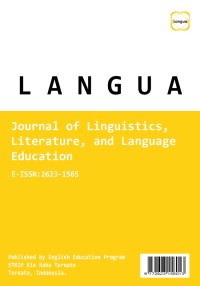Teaching English Poetry in EFL Classroom through Classroom Presentation
Abstract
The objective of this research was to know about how to teach English poetry in the EFL classroom through classroom presentation. Poetry has been used in teaching and learning English in the classroom. Many educators have attempted to deal with poetry in the EFL classroom. English poetry is a subject in the fifth semester of the English Department at STKIP Kie Raha Ternate. The research design used in this research is qualitative research. The population in this research was all students of the English Department of STKIP Kie Raha Ternate, and the samples of this research were 20 fifth-semester students of the English department of STKIP Kie Raha Ternate. To collect the data the researcher used classroom observation and documentation. To analyze the data, the researcher was analyzed the data from the result of classroom observation or in other words the researcher analyzes the result of classroom presentation. The analysis showed that classroom presentation can enhance the students’ achievement in learning poetry.
Downloads
References
Anneberg (2013). Making Meaning in Literature: A Workshop for Teachers grade 6-8. Retrieved at http://www.learner.org/resources/series170.html on June 13, 2013.
Antika, R. (2016). Poetry in EFL Classroom. TELL-US Journal, 2(2), 20-35
Bagherkazemi, M. & Alemi, M. (2010). Literature in the EFL/ESL Classroom: Consensus and Controversy, (1). LiBri. Linguistic and Literary Board Research and Innovation. Retrieved at http://brain.edusoft.ro/index.php/libri/article/viewFile/71/190 on June 7, 2013
Clandfield, L. (2003). Teaching materials: using literature in the EFL/ESL classroom. Retrieved from http://www.onestopenglish.com/support/methodology/teaching-materials/teaching-materials-using-literature-in-the-efl/-esl-classroom/146508.article on June 10, 2013.
Duff, A., & Maley, A. (1989). The Inward Ear. Cambridge: Cambridge University Press.
Guizar, N. (1992). Discover Poetry: Using Poetry in the ESL/EFL Classroom. Mextesol Journal, 16(1), 9-14
Hay, S.A. (2004). Teaching English Poetry to Turkish Undergraduates: Comprehension Techniques Matter.
Heath, S. B. (1996). Re-creating Literature in the ESL Classroom. TESOL Quarterly, 30s, 776-79
Hess, N. (2003). Real Language through Poetry: A formula for Meaning Making, ELT Journal 57(1)19-25
Hill, J. (1986). Using Literature in Language Teaching. London: Macmillan
Hişmanoğlu, M. (2005). Teaching English through Literature. Journal of Language and Linguistic Studies, 1(1), 53-66
Kellem, H. (2009). The Formeaning Response Approach Poetry in the EFL Classroom. English Teaching Forum, 47(4), 12-17
Khansir, A. A. (2012). Teaching Poetry in the ELT Classroom. International Review of Social Sciences and Humanities, Retrieved at http://irssh.com/yahoo_site_admin/assets/docs/24_IRSSH-288 V3N1.131231639.pdf on June 10, 2013
Khatib, M. (2011). A new approach to teaching English poetry to EFL students. Journal of English Teaching and Research. 2(1), 164-169
Kırkgöz, Y. (2008). Using poetry as a model for creating English poems. Dil ve Dilbilimi Çalışmaları Dergisi, 4(2).
Kong, F. (2010). On the Effectiveness of Applying English Poetry to Extensive Reading Teaching. Journal of Language Teaching and Research, 1(6), 918-921
Lazar, G. (1990). Exploring Literary Texts with the Language Learner. TESOL Quarterly, 30s,773-75
Llach, P.A. (2007). Teaching Language through Literature: The Waste Land in the ESL Classroom. Odisea: Revista de Estudios Ingleses. Retrieved at http://www.ual.es/odisea/Odisea08_Agustin.pdf on June 10, 2013.
Madden, F. (2002). Exploring Poetry; Writing and Thinking about Poetry. New York: Addison Weasley Longman
Maley, A. & Duff, A. (2007). Literature. 2nd edition. Oxford: Oxford University Press.
Mittal, R. (2014). Teaching English through Poetry: A Powerful Medium for Learning Second Language. IOSR Journal of Humanities and Social Science, 19, 21-23
Norris, J. (2010). Using Poetry to Teach Reading Comprehension Strategies to English Language Learner. Unpublished thesis. Minnesota: Hamline University.
Panavelli, A. (2011). Teaching Poetry in an EFL/ESL Class: An Integrative and Communicative Approach. English Language Teaching Voices. Retrieved at http://eltvoices.in/Volume1/Issue3/EVI13.2.pdf on June 7, 2013
Rachmatia, M. (2015). Poetry as Teaching Resource in ELT Classroom. Paper Presented at Fourth South Region Sumatera TEFLIN, Sriwijaya University, Indonesia, February 7, 2015
Reilly, N. (2012). What is the Role of Poetry in Second Language Learning and Teaching? Research in Second Language Acquisition
Roebuck, C. D. (2015). Impact and import of poetry in high school pedagogy: a study of practice and student learning (Doctoral dissertation, Rutgers University-Graduate School-New Brunswick).
Rush, P. (2001). Behind the Lines: Using Poetry in the Language Classroom. Retrieved at http://library.nakanishi.ac.jp/kiyou/gaidai(30)/05.pdf on June 10, 2013
Sadler, R.K. and Hayllar, T. (1991). Poetry for Pleasure. South Yara: Macmillan.
Stange, T. V., & Wyant, S. L. (2008). Poetry Proves to be Positive in the Primary Grades. Reading Horizons: A Journal of Literacy and Language Arts, 48 (3)
The Northern Territory Department of Employment, Education and Training. 2006. Poetry. Northern Territory of Australia. Retrieved at http://www.education.nt.gov.au/__data/assets/pdf_file/0019/5248/poetry.pdf on June 10, 2013.
Tomlinson, C.M. & Brown, C.L. (2002). Essential of Children’s Literature. 4th edition. Boston: Allyn and Bacon.
Van, T.T.M. (2009). The relevance of literary analysis to teaching literature in the EFL classroom. English Teaching Forum, Retrieved at http://www.eric.ed.gov/PDFS/EJ923454.pdf on June 7, 2013
Wordsworth, W. & Coleridge, S. M. (1989). Lyrical Balad. Penguin Classics
Copyright (c) 2021 S Syamsia, Hamid Ismail

This work is licensed under a Creative Commons Attribution 4.0 International License.
Authors who publish with Langua Journal of Linguistics, Literature, and Language Education agree to the following terms:
- Authors retain copyright and grant the journal right of first publication with the work simultaneously licensed under a Creative Commons Attribution License that allows others to share the work with an acknowledgement of the work's authorship and initial publication in Langua.
- Authors are able to enter into separate, additional contractual arrangements for the non-exclusive distribution of the journal's published version of the work (e.g., post it to an institutional repository or publish it in a book), with an acknowledgement of its initial publication in Langua.
- Authors are permitted and encouraged to post their work online (e.g., in institutional repositories or on their website) prior to and during the submission process, as it can lead to productive exchanges, as well as earlier and greater citation of published work.






